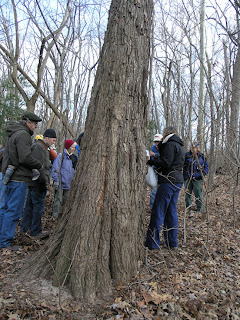 |
| Circling a champion Tulip Poplar at Chapman's Forest--there is a third person behind the tree, but the circumference was so large, he couldn't join hands with the young lady on the left. |
Last Sunday before Christmas the
Maryland Native Plant Society (MNPS) did its annual Winter Solstice Walk at
Chapman's Forest. I stayed at my friend
Patrise's house for the weekend so I could be close-by, and Linda and I joined the group. Only about six or seven of us had registered on-line, so I was shocked to see that more than 50 of us showed up!
Turns out that this is a very popular event and many of the local folk who worked for a long time to obtain the historic landmark preservation status for Chapman's have been doing this solstice walk for years. One lady told me this year was the best weather they've had so far, so that may account for the number of folk there. The day started out overcast, with temperatures in the upper forties, but after about an hour, a wan winter sun broke out and it began to warm up.
Our leader, Rod Simmons, talked knowledgeably about the different types of forest and plant communities as he led us through the upper forests of shell marl, and told about the many species of oaks found in this tract, their distinguishing characteristics, etc. The leaves are the best indicators as to the species, though general shape, the terrain and the acorns also hold clues. I had no idea there were so many different types of oaks: southern red oak, chinquapin, post, pagoda, and chestnut oak, in addition to the better-known white oak, scarlet oak, pin, and black oak. Some of these are unusual in our area, and found mostly in old-growth forest such as Chapman's.

After a couple of hours of hiking around, we took break for lunch. Rod had announced we would toast the solstice toast during our break, and I thought he was joking, that it would be a symbolic toast with the water we had each brought along--wrong! A couple of the men in the group had brought bottles of Glenlivet single-malt scotch and some wine for the occasion, along with tiny one-shot plastic cups that they passed around for the toast.
After our repast, we continued on down a steep ravine. Sadly, a champion-sized Tulip Poplar that had stood there for centuries had been brought down by this past September's storms and thirteen inches of rain. There were still plenty of other champion-size trees to see.
Rod seemed to be able to navigate by these trees, which were probably like old friends to him. He allowed that he and several other men in the group had been hiking this tract since the early nineties. We stopped by a huge pagoda oak before turning towards the Potomac River, where a high bluff offered spectacular views of Mason's Neck in Virginia on the opposite shore.

We continued along the river, down another steep ravine to an area with a couple of old abandoned houses. We were told these cabins were an old duck-hunting camp that President Hoover used to frequent in his day. There was an Osage orange tree growing near the shore, and the largest sassafras tree I'd ever seen--the bark exhibits unusual ridges when the trees get to a certain age. If one flakes off chunks of the bark, one can smell the spicy scent of sassafras.

Eventually we worked our way up another hillside where I recognized the old brick chimney near the place where Virginia bluebells bloom in the spring, and realized were were now very close to Mont Aventine and our starting point. The sun was low on the horizon--we had been hiking for over six hours and who knows how many miles over some fascinating terrain. A few folks had dropped by the wayside due to other commitments, but I was surprised by how many of the group finished the course, including several elderly among us. I was bone-tired, so I can imagine how they felt, yet it was such an enjoyable experience!
I hope to explore more of Chapman's next the spring, and definitely repeat the solstice walk next year. For more photos of the
Winter Solstice Walk at Chapmans, click on the link to my Flickr album.



































